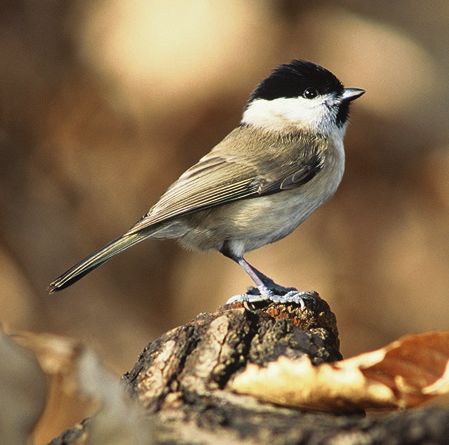Marsh Tit (Poecile palustris) - wiki Marsh Tit
From Wikipedia, the free encyclopedia
[Photo] Sumpfmeise (Poecile palustris). Photographer: Steffen Hannert. Source: Vogelruf.de, BirdGallery, http://www.vogelruf.de/galerie/
The Marsh Tit, Poecile palustris, is a passerine bird in the tit family Paridae. It is a widespread and common resident breeder throughout temperate Europe and northern Asia. It breed in northern Spain. It does not breed in Ireland or the colder northern countries. It is resident, and most birds do not migrate. There has been a >60% decline in numbers in Britain between 1960 and 2000, with numbers down to 52,800 pairs.
The head and neck are glossy blue-black; the chin and upper throat are black, the feathers of the latter edged with white. The cheeks are white, fading into off-white on the sides of the neck, the back is sandy brown with an olive tinge, and the rump browner. The absence of the nape spot distinguishes it at once from the Coal Tit.
The wings and tail are greyish-brown, and there is often a distinct wing bar on the greater coverts. The underparts are greyish white, shading into buff on the flanks. As a rule the upper and under surfaces are more sharply defined than in the Willow Tit, its probable sister species. The bill is black with pale cutting eges (a good distinction from Willow Tit), the legs lead-coloured, and the irides very dark brown (paler in juveniles).
It can be told from the Willow Tit by its glossy blue-black head and squarer tail; the black bib under the biill is smaller, and the wings are uniformly brown without a conspicuous lighter area towards the tips when at rest. The sexes are alike and seasonal changes are not striking; the young are duller. Length is 11.5 cm, and wing range from 60-70 mm.
"Marsh Tit" is a misleading rather than incorrect name, for though the bird is found in damp and marshy places, it is as common in dry woods and hedgerows and even occurs in gardens. In mixed winter tit flocks, seldom more than one or two Marsh Tits are present, and parties of this species alone are infrequent. Its performances in the bushes and branches are just as neat and agile as those of other tits; it often hangs upside down by one leg. Like the other chickadees it has a large range of call notes; most typical it the explosive 'pitchou' note, given when agitated. This note often leads into a typical chickadee note: pitchou-bee-bee-bee. Unlike many other chickadees, however, the Marsh Tit has a well-defined song and a wide song repertoire. Individual birds can have more than five songs, which they use interchangeably. Some of the more common songs include a typical tit-like, ringing, 'schip-schip-schip-schip-ship', and a more liquid 'tu-tu-tu-tu-tu' and sometimes a sweet 'tyeu-tyeu-tyeu-tyeu-tyeu'.
The food is animal or vegetable; caterpillars and other insects, and spiders are eaten, and seeds of various kinds, including those of the thistle. Unlike most other tits, this bird has been observed to store the food for the winter, by hiding seeds behind tree bark or in similar semi-hidden places.
The nest is occasionally in a hole in the ground, but the bird is more of a tree species than some of its relatives. It selects a hole in a rotten willow or other trunk or stump for choice, and though it never starts a hole, it undoubtedly enlarges the hollow, carrying the chips to a distance before dropping them. The hole may be within a centimetres or two of the ground or high as 10 m. Wool, hair, fur and moss are felted together, and occasionally willowdown is added, but the quantity of material used is variable. Feathers are very rarely used.
Five to nine eggs of the usual tit type are laid late in April or in May, and second broods are recorded though extremely rare in Britain. Most second broods are replacement clutches. The bird sits closely, and gives a typical tit 'hissing display' if disturbed.
Systematics
Most authorities retain Poecile as a subgenus within the genus Parus, but the American Ornithologists' Union treats it as a distinct genus. This is supported by mtDNA cytochrome b sequence analysis; within Poecile, the Marsh Tit is part of a group of Eurasian "typical chickadees" that includes also the Willow Tit, P??re David's Tit, and in all probability also the Songar Tit.(Gill et al., 2005)
The subspecies hypermelaena is sometimes considered a distinct species, the Black-bibbed Tit.
http://en.wikipedia.org/wiki/Marsh_Tit
| The text in this page is based on the copyrighted Wikipedia article shown in above URL. It is used under the GNU Free Documentation License. You may redistribute it, verbatim or modified, providing that you comply with the terms of the GFDL. |
